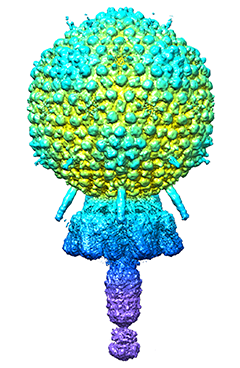Scientists from the University of Alabama at Birmingham used cryo-electron microscopy to reveal the structure of a bacterial virus in extraordinary detail. This is the first structure of a virus capable of infecting Staphylococcus epidermidis, and high-resolution structure knowledge provides a critical link between viral biology and the virus’s potential therapeutic usage to treat bacterial diseases.
 The Andhra phage. Image Credit: Dokland lab
The Andhra phage. Image Credit: Dokland lab
Bacteriophages, sometimes known as “phages,” are viruses that infect bacteria. Terje Dokland, PhD, of the University of Alabama at Birmingham, and Asma Hatoum-Aslan, PhD, of the University of Illinois Urbana-Champaign, have outlined atomic models for all or part of 11 distinct structural proteins in phage Andhra. The findings were published in Science Advances.
Andhra belongs to the picovirus family. It only has S. epidermidis as a host. This skin bacteria seems typically harmless, although it is a leading source of indwelling medical device infections.
Picoviruses are rarely found in phage collections and remain understudied and underused for therapeutic applications.”
Asma Hatoum-Aslan, Phage Biologist, University of Illinois
With the growth of antibiotic resistance in S. epidermidis and the related pathogen Staphylococcus aureus, investigators have reignited interest in possibly employing bacteriophages to treat bacterial infections. Picoviruses invariably destroy the cells they infect after attaching to the bacterial cell wall, breaking through it enzymatically, piercing the cell membrane, and injecting viral DNA into the cell.
They also have additional characteristics that make them appealing therapeutic possibilities, such as a tiny genome and the inability to transfer bacterial genes between bacteria.
It will be possible to create unique phages suited to a certain purpose through genetic engineering if one is familiar with the Andhra protein structure and is aware of how those structures enable the virus to infect a bacterium.
The structural basis for host specificity between phages that infect S. aureus and S. epidermidis is still poorly understood. With the present study, we have gained a better understanding of the structures and functions of the Andhra gene products and the determinants of host specificity, paving the way for a more rational design of custom phages for therapeutic applications. Our findings elucidate critical features for virion assembly, host recognition and penetration.”
Terje Dokland, Professor, Microbiology, University of Alabama at Birmingham
Terje Dokland is also the director of the UAB Cryo-Electron Microscopy Core.
Staphylococcal phages typically have a small spectrum of bacteria they can infect, dependent on the varied polymers of wall teichoic acid on the surface of different bacterial strains. “This narrow host range is a double-edged sword: On one hand, it allows the phages to target only the specific pathogen causing the disease; on the other hand, it means that the phage may need to be tailored to the patient in each specific case,” Dokland adds.
Andhra’s main structural component is a 20-faced, icosahedral capsid head that houses the viral genome. A short tail is attached to the capsid. The tail is primarily responsible for attaching to S. epidermidis and breaking down the cell wall enzymatically. The viral DNA is introduced into the bacterium by the tail. The portal connecting the capsid and the tail, as well as the stem, appendages, knob, and tail tip, are all parts of the tail.
Multiple copies of each of the 11 distinct proteins are present and come together to form the viral particle. The capsid, for example, is made up of 235 copies of two proteins, while the other nine virion proteins have copy counts ranging from two to 72. The virion is composed of 645 protein components, including two copies of a 12th protein, the structure of which was estimated using the protein structure prediction program AlphaFold.
The atomic models described by Dokland, Hatoum-Aslan, and co-first authors N'Toia C. Hawkins, PhD, and James L. Kizziah, PhD, UAB Department of Microbiology, display the structures for each protein—as explained in a molecular language like alpha-helix, beta-helix, beta-strand, beta-barrel or beta-prism.
The researchers have defined how each protein links to other copies of the same protein type, for example, to form the capsid’s hexameric and pentameric faces, as well as how each protein engages with neighboring distinct protein types.
The usage of electron microscopes, which use a stream of accelerated electrons to illuminate a target, provides a better resolution than a light microscope. Cryo-electron microscopy adds the aspect of super-cold temperatures, making it particularly effective for near-atomic structural resolution of bigger proteins, membrane proteins, or lipid-containing samples such as membrane-bound receptors, as well as complexes of multiple biomolecules.
Over the last eight years, new electron detectors have resulted in a significant increase in resolution for cryo-electron microscopy over conventional electron microscopy. The following are key components of the so-called "resolution revolution" in cryo-electron microscopy:
- Freezing aqueous samples in liquid ethane that has been cooled to below −256 ℉. Water freezes to a window-like “vitreous ice” instead of ice crystals, which damage samples and disperse the electron beam.
- To avoid protein damage, the material is held at super-cold temperatures in the microscope, and a low dose of electrons is employed.
- High-speed direct electron detectors can count individual atoms at hundreds of frames per second, allowing sample movement to be adjusted in real time.
- Advanced computing combines dozens of images to create high-resolution three-dimensional structures. Terabytes of data are processed by graphics processing units.
- A three-dimensional tomographic image, like a CT scan in the hospital, can be created by tilting the microscope stage that is holding the sample as photos are captured.
The UAB researchers began their examination of the Andhra virion structure with 230,714 particle images. The 186,542, 159,489, 159,489, and 159,489 images were used to begin the molecular reconstruction of the capsid, tail, distal tail, and tail tip, respectively. The resolution ranged between 3.50 and 4.90 Å.
Source:
Journal reference:
Hawkins, N. T. C., et al. (2022) Structure and host specificity of Staphylococcus epidermidis bacteriophage Andhra. Science Advances. doi.org/10.1126/sciadv.ade0459.